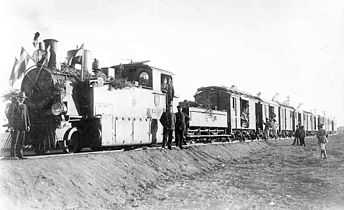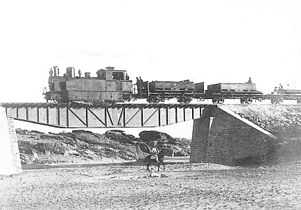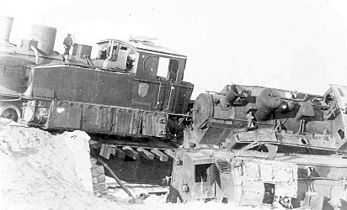South West African 2-8-0T
| South West African 2-8-0T Ex DSWA 2-8-0T | |
|---|---|
|
Eight-coupled tank, circa 1912 | |
| Type and origin | |
| Power type | Steam |
| Designer | Orenstein & Koppel |
| Builder | Orenstein & Koppel |
| Serial number | 1870-1875, 2069-20, 2356-2361, 2732-2734, 3182-3184, 4198-4199 [1] |
| Build date | 1906-1910 |
| Total produced | 23 |
| Specifications | |
| Configuration | 2-8-0 "Consolidation" |
| Gauge | 3 ft 6 in (1,067 mm) Cape gauge |
| Driver diameter | 39 3⁄8 in (1,000 mm) |
| Length | 29 ft 6 9⁄16 in (9.006 m) |
| Axle load | 7 8⁄20 long tons (7.5 t) |
| Locomotive weight | 34 10⁄20 long tons (35.1 t) |
| Fuel type | Coal |
| Boiler pressure | 171 psi (1,180 kPa) |
| Firegrate area | 12.5 sq ft (1.161 m2) |
| Cylinders | Two |
| Cylinder size |
Compound engines: Not known Simplex engines: 14 9⁄16 in (370 mm) bore 19 11⁄16 in (500 mm) stroke |
| Valve gear | Walschaerts |
| Performance figures | |
| Tractive effort | 13,580 lbf (60 kN) at 75% pressure |
| Career | |
| Operator(s) |
Lüderitzbucht Eisenbahn South African Railways [2] |
| Number in class | 14 |
| Number(s) | DSWA 1-18, 20-22 |
| Delivered | 1907-1910 |
| First run | 1907 [3] |
The South West African 2-8-0T of 1907 was a South West African steam locomotive from the Deutsch-Südwest-Afrika era.
Between 1907 and 1910 the Lüderitzbucht Eisenbahn (Lüderitzbucht Railway) in Deutsch-Südwest-Afrika (German South West Africa) placed twenty-three tank locomotives with a 2-8-0 Consolidation type wheel arrangement in service. After the First World War, when all railways in the territory came under the administration of the South African Railways in 1922, five of these locomotives still survived. They were not classified or renumbered but were referred to as the Eight-Coupled Tanks.[2][3]
Manufacturer
In 1907 eight Cape Gauge tank locomotives with a 2-8-0 Consolidation type wheel arrangement were delivered to the Lüderitzbucht Eisenbahn in Deutsch-Südwest-Afrika (now Namibia) by Orenstein & Koppel, numbered in the range from 1 to 8 and all built in 1906. The first six of these locomotives were two-cylinder compound engines that were built to the Von Borries principles and were the only compound locomotives of this design to serve in Southern Africa. The other two, numbers 7 and 8, were two-cylinder simple-expansion (simplex) engines.[1][3]
A second batch of thirteen locomotives was delivered from the same manufacturer between 1907 and 1910, built between 1907 and 1909 and numbered in the ranges from 9 to 18 and 20 to 21. They were all two-cylinder simplex locomotives, identical to the last two of the first batch. Both versions of the type were equipped with dust shields over the driving wheels and valve gear to protect the moving parts from blown sand in the Namib desert.[1][3]
A final two locomotives of the same type were delivered, both built in 1910. Their engine numbers are not known.[1]
Two-cylinder compound expansion
In a compound locomotive steam is expanded in phases. After being expanded in a high pressure cylinder and having then lost pressure and given up part of its heat, it is exhausted into a larger volume low pressure cylinder for secondary expansion, after which it is exhausted through the smokebox. By comparison, in the more usual arrangement of simple expansion, steam is expanded just once in any one cylinder before being exhausted through the smokebox.[4]
A two-cylinder compound expansion locomotive using the "Von Borries" system of compounding has one high pressure and one low pressure cylinder.[5]
Service
Lüderitzbucht Eisenbahn
The locomotives were placed in service on the line between Lüderitzbucht and Keetmanshoop and on the lines from the latter north to Windhoek and south to Warmbad. Since the radius of operation of a tank locomotive is limited by the capacity of its small on-board coal bunker, these locomotives often ran with an auxiliary tender coupled to them to extend their range.[2]
South African Railways
During the German South West African campaign in World War I the territory, including the railways, was taken over by the South African military. On 1 April 1922 all railways in the former German colony came under the administration of the South African Railways (SAR). Five of the simplex locomotives still survived to be taken onto the SAR roster, amongst them numbers 10, 18, 20 and 21. They retained their German colonial era engine numbers and were not classified by the SAR, but were referred to as the Eight-Coupled Tanks.[2][3]
The Eight-Coupled Tanks remained in SAR service in South West Africa into the late 1930s.[2]
Works numbers
The works numbers, year built, engine numbers and known disposition of the Eight Coupled Tanks are shown in the table.[1]
Works no. |
Year |
DSWA no. |
1922 |
|---|---|---|---|
| 1870 | 1906 | 1 | |
| 1871 | 1906 | 2 | |
| 1872 | 1906 | 3 | |
| 1873 | 1906 | 4 | |
| 1874 | 1906 | 5 | |
| 1875 | 1906 | 6 | |
| 2069 | 1906 | 7 | |
| 2070 | 1906 | 8 | |
| 2356 | 1907 | 9 | |
| 2357 | 1907 | 10 | SAR |
| 2358 | 1907 | 11 | |
| 2359 | 1907 | 12 | |
| 2360 | 1907 | 13 | |
| 2361 | 1907 | 14 | |
| 2731 | 1908 | 15 | |
| 2732 | 1908 | 16 | |
| 2733 | 1908 | 17 | |
| 2734 | 1908 | 18 | SAR |
| 3182 | 1908 | 20 | SAR |
| 3183 | 1909 | 21 | SAR |
| 3184 | 1909 | 22 | |
| 4198 | 1910 | ||
| 4199 | 1910 | ||
Sides illustrated
The main and the following pictures serve to illustrate the Eight-coupled tank from both sides.
-

Eight-coupled tank at Seeheim during the official opening of the Lüderitz Railway
-

Eight-coupled tank on the North-South Railway south of Windhoek
-

Eight-coupled tanks sabotaged by retreating German forces in World War I
See also
- List of South African locomotive classes
- South African locomotive history
- South West African 2-8-0
- The 2-8-0 "Consolidation"
References
|
- ↑ 1.0 1.1 1.2 1.3 1.4 Lieferverzeichnis O and K Dampfloks
- ↑ 2.0 2.1 2.2 2.3 2.4 Paxton, Leith; Bourne, David (1985). Locomotives of the South African Railways (1st ed.). Cape Town: Struik. p. 99, 149. ISBN 0869772112.
- ↑ 3.0 3.1 3.2 3.3 3.4 Dulez, Jean A. (2012). Railways of Southern Africa 150 Years (Commemorating One Hundred and Fifty Years of Railways on the Sub-Continent - Complete Motive Power Classifications and Famous Trains - 1860-2011) (1st ed.). Garden View, Johannesburg, South Africa: Vidrail Productions. p. 35. ISBN 9 780620 512282.
- ↑ Compounding Steam Engines
- ↑ Compound locomotive
_ex_DSWA.jpg)